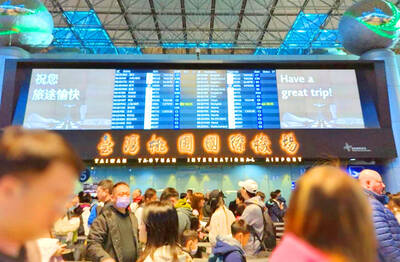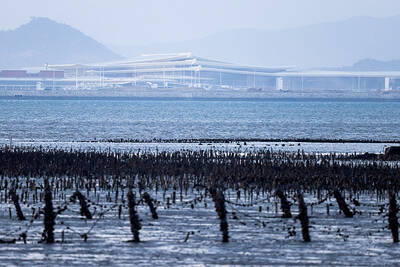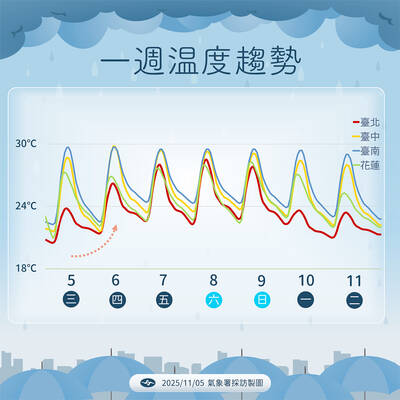Wearing panda costumes and panda hats, Tibetan activists handed out flyers yesterday outside the Taipei Zoo with cartoons directed at children explaining the connection between the giant pandas and Tibet.
“Do you know where Tuan Tuan (團團) and Yuan Yuan (圓圓) come from? They come from Tibet,” Taiwan Friends of Tibet (TFOT) vice chairman Yang Chang-chen (楊長鎮) told a group of children and their parents as they waited in line to take pictures with a Tibetan activist dressed in a panda costume outside the zoo.
The giant pandas Tuan Tuan and Yuan Yuan were gifts from China and arrived in December.
Activists handed out flyers to people waiting in line to get a photo and to passersby. The cartoon explained the Tibetan background of Sichuan Province.
“You all know that pandas come from Wolong in Sichuan, but do you know that Wolong is also home to Tibetans?” the flyer said.
It said the name “Wolong” (臥龍) came from the word wo-dhom in the local dialect of the Tibetan language, meaning “the place where pandas live.” Dhom is the Tibetan word for “panda” and wo the word for “residence.”
“Many people think that pandas are from China, but pandas actually lived side-by-side with Tibetans throughout history,” Yang said. “We want people to know that and perhaps they will realize the threat China can pose to its neighbors.”
The flyer also said events would be held across the globe to commemorate the 50th anniversary of the 1959 Tibetan uprising against Chinese rule.
Most people reacted positively to the activists and many seemed surprised by the information on the flyer.
Freddy Lim (林昶佐), the lead vocalist of the heavy metal band Chthonic, and the band’s bassist, Doris Yeh (葉湘怡), were among the dozens of volunteers distributing flyers. Some of the band’s fans also joined in the effort.
One of the volunteers was an off-duty police officer who helped hand out stacks of flyers “because my son is a big fan of Chthonic,” he said.
But not everyone was interested in hearing what the activists had to say about Wolong.
When Yeh tried to give an elementary school student a flyer at the zoo’s entrance and asked: “Do you want to know where Tuan Tuan and Yuan Yuan come from?” the child shouted in response: “I don’t like Tuan Tuan and Yuan Yuan and I’m not here to see them!”
Gary Chiang (江季剛), spokesman of Guts United Taiwan, a group that co-organized the effort, said it was a success.
“We handed out about 2,500 flyers the whole morning and I’d say it was quite a big success,” he said after the activists wrapped up their activity shortly after noon. “We plan to do this regularly until March 14, when this year’s free Tibet parade is held in Taipei.”

Three Taiwanese airlines have prohibited passengers from packing Bluetooth earbuds and their charger cases in checked luggage. EVA Air and Uni Air said that Bluetooth earbuds and charger cases are categorized as portable electronic devices, which should be switched off if they are placed in checked luggage based on international aviation safety regulations. They must not be in standby or sleep mode. However, as charging would continue when earbuds are placed in the charger cases, which would contravene international aviation regulations, their cases must be carried as hand luggage, they said. Tigerair Taiwan said that earbud charger cases are equipped

Foreign travelers entering Taiwan on a short layover via Taiwan Taoyuan International Airport are receiving NT$600 gift vouchers from yesterday, the Tourism Administration said, adding that it hopes the incentive would boost tourism consumption at the airport. The program, which allows travelers holding non-Taiwan passports who enter the country during a layover of up to 24 hours to claim a voucher, aims to promote attractions at the airport, the agency said in a statement on Friday. To participate, travelers must sign up on the campaign Web site, the agency said. They can then present their passport and boarding pass for their connecting international

UNILATERAL MOVES: Officials have raised concerns that Beijing could try to exert economic control over Kinmen in a key development plan next year The Civil Aviation Administration (CAA) yesterday said that China has so far failed to provide any information about a new airport expected to open next year that is less than 10km from a Taiwanese airport, raising flight safety concerns. Xiamen Xiangan International Airport is only about 3km at its closest point from the islands in Kinmen County — the scene of on-off fighting during the Cold War — and construction work can be seen and heard clearly from the Taiwan side. In a written statement sent to Reuters, the CAA said that airports close to each other need detailed advanced

UNKNOWN TRAJECTORY: The storm could move in four possible directions, with the fourth option considered the most threatening to Taiwan, meteorologist Lin De-en said A soon-to-be-formed tropical storm east of the Philippines could begin affecting Taiwan on Wednesday next week, the Central Weather Administration (CWA) said yesterday. The storm, to be named Fung-wong (鳳凰), is forecast to approach Taiwan on Tuesday next week and could begin affecting the weather in Taiwan on Wednesday, CWA forecaster Huang En-hung (黃恩鴻) said, adding that its impact might be amplified by the combined effect with the northeast monsoon. As of 2pm yesterday, the system’s center was 2,800km southeast of Oluanbi (鵝鑾鼻). It was moving northwest at 18kph. Meteorologist Lin De-en (林得恩) on Facebook yesterday wrote that the would-be storm is surrounded by